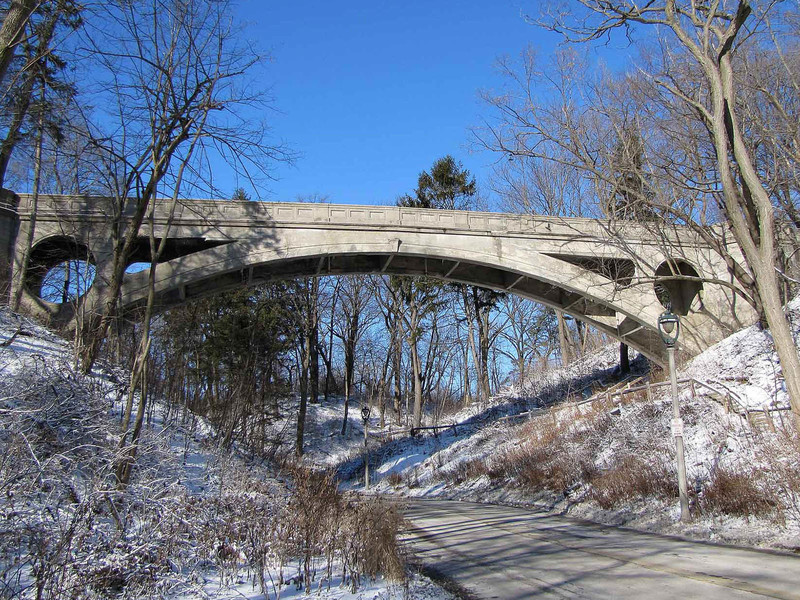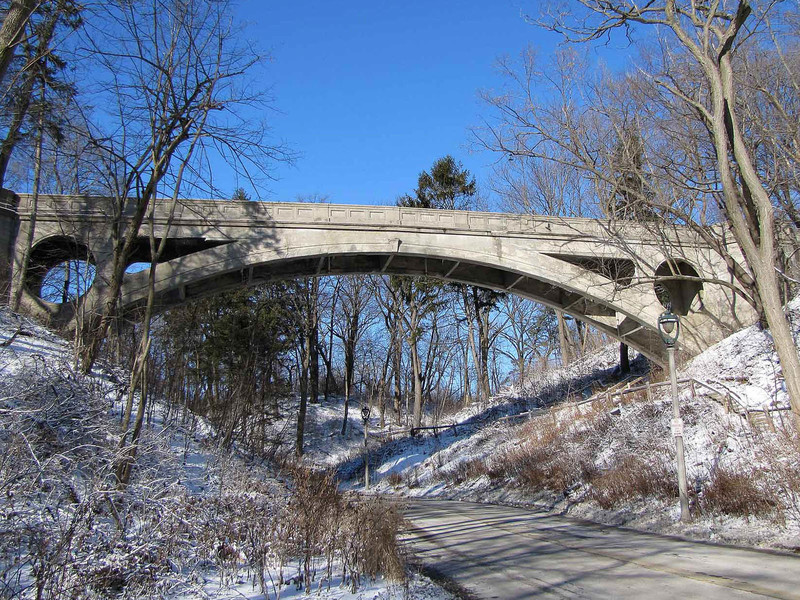For years, I, and seemingly everyone else, may have been mis-attributing the design of the newly refurbished Ravine Road pedestrian bridge in Lake Park to Milwaukee architect Alfred C. Clas, who was, at the time, in partnership with George Bowman Ferry.
But it has been brought to my attention that the bridge, built in 1905 in the Olmsted-designed park, does not appear to be a work by Clas at all.
Michael Smith, who is the author of a forthcoming book – to be published in about 12-18 months by the University of Michigan Press – about the construction process used for the bridge, sent me this message.
“I recently completed a book on Julius Kahn, inventor of the ‘Kahn System’ of concrete reinforcement that was used to construct the bridge,” Smith wrote.
“The Lake Park Bridge is prominently featured in the book as an example of the innovative work that transformed bridge construction early in the 20th century.
“In the course of my research for the book I discovered that the bridge was in fact designed by the contractor, the Newton Engineering Company of Milwaukee.
"Newton was founded by Ralph E. and Alfred L. Newton, both of whom received degrees in civil engineering at the University of Michigan (coincidentally, during the same time as Julius Kahn was acquiring the same degree there).”
Newton was also involved in the construction of the 1911 Grand Avenue viaduct.
Smith then provided an excerpt from his book, which is currently in the editing process.
“The architectural design for the bridge has in later years been credited to George B. Ferry and Alfred C. Clas of the Milwaukee firm of Ferry and Clas, though a contemporary account states: ‘The design was prepared by the contractor, and the contract let after some slight modifications had been made with reference to the architecture’,” he wrote.
“At the time of the bridge’s construction, Clas served as one of Milwaukee’s park commissioners, a position he could not legally hold had he been hired by the commission as architect of the bridge. Nevertheless, the records of the park commission include numerous payments to Clas for architectural services, so the city and park commission apparently choose to overlook the conflict of interest.”
Clas has also been credited with the 1908 staircase connecting the pavilion with the lakefront.
Smith’s research showed that, “Newton Engineering was selected as contractor on the basis of its low bid for construction, which, at $6,246, was a mere $46 less than the next lowest bid. The bridge was completed around the middle of October 1905.”
Two of four sheets of original architectural plans for the bridge, provided by Philip Schultz of Lake Park Friends, clearly name Ferry & Clas as architects, while two others omit that attribution entirely, which cloud a definitive attribution, but would seem to suggest that the landmark architectural firm did indeed design the bridge.
The drawings bearing the Ferry & Clas attribution show the bridge as it was ultimately built.
But, Smith remains confident in the attribution to Newton.
"The first of these drawings is the 'strain sheet' and includes the note 'This strain sheet is the exclusive property of the Newton Engineering Company,' clearly indicating that it was prepared by Newton," he says. "I see that the firm of Ferry and Clas is listed on the plans as the architect, but this seems to me to be a normal instance of Ferry and Clas being the 'architect of record.'
"Any construction requires an architect and in this case, it makes sense that the Park Commission would have their own guy serve as the architect of record. I have found numerous instances where the architect listed as 'the architect' had little or nothing to do with the design and construction of a building or other structure. This is most likely the case here.
"Given the clear wording of the Engineering Record article, the indisputable authorship of the plans, the illegality of Clas serving on the commission while providing architectural services to same, and the criticism heaped on the bridge by Clas, the most likely conclusion is that Newton designed the bridge."
It's also notable that Clas was apparently unhappy with the completed bridge.
“During construction, drainage problems were found that hampered the foundation work and, as a result, Newton requested an additional $664 from the park commission to cover the extra costs,” wrote Smith, who provided the highlighted excerpts from 1905 issues of Engineering Record that you can see embedded in this post.
“This led to a dispute between park commissioner Clas and Newton, with Clas claiming the ‘bridge was a poor piece of work’ and refusing to pay until ‘certain alleged defects’ were remedied. In the end, Newton was paid the extra compensation they sought.”
In its 2016 Cultural Heritage Assessment Study and Report on the span, the City of Milwaukee's Historic Preservation Commission harbors little doubt as to the bridge's designers.
"Ferry & Clas designed the bridge in neoclassical styling to further compliment their design for the Pavilion and Grand Staircase, the unit of three pieces finished to create a grand procession along the eastern edge of the park itself," the report noted.
"Though the Concrete Arch Bridge does not seem to hold the same national prestige as much of Ferry & Clas’s other works, such as the Pabst Mansion, it stands as a significant part of their civil repertoire. One of the only bridges in Milwaukee on record as credited to the firm, Ferry & Clas’s bridge over Ravine Road stands as an example of their ability to deploy high artistry even on the smallest scale. "
(NOTE: This post was updated on Nov. 10, 2022, and will be updated again as more evidence is uncovered.)
Born in Brooklyn, N.Y., where he lived until he was 17, Bobby received his BA-Mass Communications from UWM in 1989 and has lived in Walker's Point, Bay View, Enderis Park, South Milwaukee and on the East Side.
He has published three non-fiction books in Italy – including one about an event in Milwaukee history, which was published in the U.S. in autumn 2010. Four more books, all about Milwaukee, have been published by The History Press.
With his most recent band, The Yell Leaders, Bobby released four LPs and had a songs featured in episodes of TV's "Party of Five" and "Dawson's Creek," and films in Japan, South America and the U.S. The Yell Leaders were named the best unsigned band in their region by VH-1 as part of its Rock Across America 1998 Tour. Most recently, the band contributed tracks to a UK vinyl/CD tribute to the Redskins and collaborated on a track with Italian novelist Enrico Remmert.
He's produced three installments of the "OMCD" series of local music compilations for OnMilwaukee.com and in 2007 produced a CD of Italian music and poetry.
In 2005, he was awarded the City of Asti's (Italy) Journalism Prize for his work focusing on that area. He has also won awards from the Milwaukee Press Club.
He can be heard weekly on 88Nine Radio Milwaukee talking about his "Urban Spelunking" series of stories.







